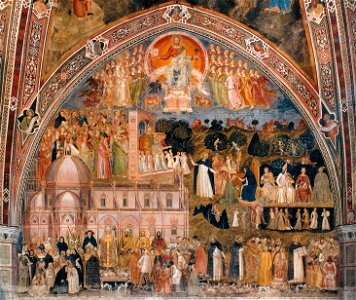The black-cloaked figures are dominican priests (the blackfriars, the order of preachers, o. P. ), and the black-and-white dogs are their symbol. (founded by st. Dominic to preach against heresies, they were referred to as "domini canes", hounds of god. )
in the left foreground there is a group of about five dozen figures representing christendom, and illustrating the religious and secular hierarchies. At the center are pope innocent vi and emperor, and at their feet are black-and-white dogs protecting the sheep. The secular figures range from the emperor down to beggars and cripples. Behind them is the great florentine duomo, representing the church. In the right foreground are three dominican saints. (their identification varies among sources. ) st. Peter martyr sends the dogs to round up lost sheep and fight off wolves. St. Dominic preaches to the people while st. Thomas debates heretics. Behind the preachers, in the right middleground, there is a group of worldly pleasure-seekers (above thomas and the heretics) and two more dominican figures (above st. Peter and st. Dominic). The faithful are being blessed and ushered to the gate of heaven, where st. Peter welcomes them. Above all is a scene of christ in majesty, with the emblems of the evangelists. The overall composition, with the heretics on the right and faithful on the left, echoes many more conventional judgment scenes. Object Type: fresco. Date: from 1365 until 1367. Medium: fresco. Depicted People: Charles IV, Innocent VI, Gil Álvarez Carrillo de Albornoz, Simone Saltarelli, William of Ockham, Michael of Cesena, Peter I of Cyprus, Amadeus VI, Count of Savoy, Giotto, Arnolfo di Cambio, Cimabue, Giovanni Boccaccio, Petrarch, Dante Alighieri, Meister Eckhart. Collection: Spanish chapelle. Andrea di Bonaiuto fresco 01
Loading...
